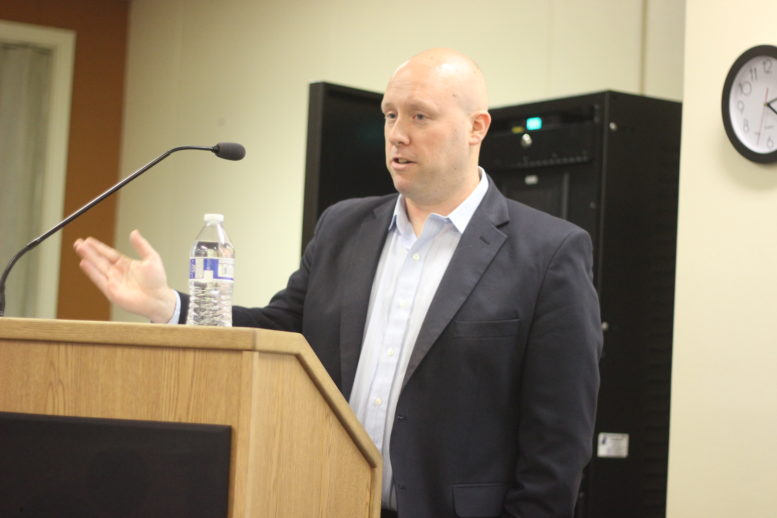By DAVID DUPONT
BG Independent News
Ohio has an enviable record of being on the winning side of Presidential elections.
Since 1896, it has voted for the winner in every election, except when it voted for Republicans Thomas Dewey in 1952 and Richard Nixon in 1960, both extremely close elections.
Author Kyle Kondik said those bellwether days may well be over.
Recently, Kondik, the editor of “Sabo’s Crystal Ball,” the University of Virginia Center for Politics’ newsletter, gave a local history award talk at Jerome Library on the Bowling Green State University campus.
He was being honored for his 2016 book “Bellwether: Why Ohio Picks the President.”
Kondik said he may have written the book just in time. The book covers the period from 1896 through 2012. And while Ohio went for Donald Trump by a comfortable margin, the election points to changes that have Ohio out of step with the national electorate.
When looking at a state’s predictive power, he said, how closely the winner’s margin of victory in the popular vote in the state matches the national margin of victory must also be considered. Over the years, Ohio has reliably been within 5 percentage points of the national popular vote total. In 2016 Trump won Ohio by 8 percentage points, 51.3 percent to 43.2 percent for Hillary Clinton. However nationally Trump trailed Clinton by 2 percentage points in the popular vote, 46.1 percent to 48.2 percent.
This, along with the changing demographics of Ohio and the nation, may being signaling an end to the state’s bellwether status.
Kondik said that the state’s electorate is less ethnically diverse that the nation as a whole, with 80 percent of its population white, compared 70 percent nationally.
The state also has fewer college graduates than the national average. Trump did extremely well with whites with no college degrees, a dominant bloc in the Ohio electorate.
But, Kondik noted, just because these voters don’t have college degrees “doesn’t mean they’re necessarily poor.”
Clinton lost areas that had voted for Barrack Obama in 2008 and 2012, and even in places such as Youngstown where she won, she won by far fewer votes.
Clinton saw “a huge erosion in important vote centers,” he said.
The question is whether they voted for a third party or just didn’t show up. African-American support, Kondik said, was weaker for Clinton than for Obama.
Nationally Clinton did do better than Obama in California, Atlanta, and cities in Texas. “She traded useful votes in the Midwest for not so useful votes in the Sunbelt,” he said.
Ohio has economic issues that played a factor. Aside from a few places such as Delaware County, north of Columbus, much of the state has stagnant or decreasing population. Much of the state’s population was born here, with few moving in. The result is “brain drain.”
And those stresses are felt by the electorate. “You can interpret the Trump vote as a cry for help,” he said. Still the final word on the 2016 election is not in. “There’s so much about this election we haven’t worked out.”
So why did Ohio earn this bellwether status in the first place?
Kondik gave several reasons dating back to the state’s founding.
Ohio, the 17th state to join the union, was considered the first American state, because it drew settlers from all 13 of the original colonies, and they settled in various parts of the territory, giving each region its own cultural flavor.
Kondik noted that Colin Woodard in his book “American Nations” divides the United States and Canada into 11 “rival regional cultures.” Ohio is divided among three – Yankeedom, the Midlands, and Great Appalachia.
Ohio also lacks a dominant region, with power centers spread out across the state. Nor does it have a dominant industry.
Maybe because of all that, the state has not had a dominant political ideology. Kondik pointed to the state’s two senators, conservative Republican Rob Portman and liberal Democrat Sherrod Brown. That split is typical. “Ohio has produced all sorts of very conservative, very liberal, very moderate politicians.”
The state does lean more Republican, and given demographic trends that could be more pronounced, he said.
But with the state’s stagnant population in contrast to other states, it has been losing seats in the U.S. House for the past several decades. It now has 18 electoral votes.
Ohio still stands as one of the decisive swing states along with Florida, Michigan, Virginia and Colorado. They hold the balance of power in the presidential election, not large states such as California, New York, or Texas, which are not competitive.
That’s key for the GOP. “Winning Ohio,” Kondik said, “is a necessary but not sufficient condition for Republican victory.”




